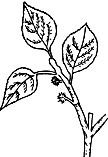| DESCRIPTION: It is a deciduous tree reaching up to 9 m in height and 9 m in width. It is in flower from August to September, and the seeds ripen from September to November. The flowers are dioecious. The fruit comprises a ball about 1.5 cm in diameter with numerous small edible fruits protruding - there is not much edible flesh but it has a good flavour. USE: The fruit can be consumed raw but prolonged ingestion is said to weaken the bones. The leaf juice is diaphoretic and laxative - it is also used in the treatment of dysentery. It is also poulticed onto various skin disorders, bites etc. The stem bark is haemostatic. The fruit is diuretic, ophthalmic, stimulant, stomachic and tonic. The root is cooked with other foods as a galactogogue. A fibre from the bark is used in making paper, cloth and rope. A leather substitute can also be made from the bark. When used for making paper branches are harvested after the leaves have fallen in the autumn, they are steamed and the fibres stripped off. The paper varies in colour if the outer and inner barks are used together or separately. The wood is coarse grained, soft, easily worked, light, not very durable. Used for cups, bowls etc. The tree is also grown as an ornamental. GROWING PERIOD: Perennial. COMMON NAMES: Paper Mulberry. FURTHER INF: It is native of East Asia and China and is occasionally naturalized in South East Europe. Its natural habitat is thickets, mountain ravines, woodland, sunny edges and forests. It can tolerate atmospheric pollution |
